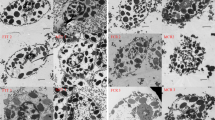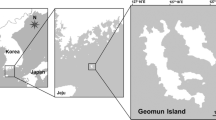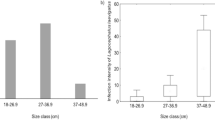Abstract
Overfishing for bleeding has been identified as the major attribute to the substantial decline of Asian horseshoe crab populations. Owing to the low willingness of Tachypleus amebocyte lysate (TAL) firms to return bled horseshoe crabs to the sea, the pond culture practice has been proposed as the alternative to keep wild-caught adults or subadults in outdoor ponds for years for repeated bleeding. The potential effects of the prolonged culture on hemolymph quality of horseshoe crabs are questioned since their general health status has an impact on the TAL production quality and the resource sustainability for bleeding. However, the baseline information regarding immune-related parameters of horseshoe crabs, particularly the Asian species, is very limited. A lacking of standardized classification scheme of horseshoe crab hemocytes makes the health indicator measurement, such as differential hemocyte counts, and the comparison among studies more challenging. In this study, hemocyte morphology and immune-related enzymatic activity in T. tridentatus and Carcinoscorpius rotundicauda were determined, in which the individuals had been kept in outdoor ponds for one year. Wright–Giemsa staining result demonstrated that three hemocyte types, namely granulocyte, non-granulocyte, and macrophage, were found. Granulocyte was the major cell type in both species, and the other two hemocyte types were noted in very small proportions surrounded by the basophil granulocytes. The cytoplasmic granules in granulocytes were stained in either blue (basophil) or purple–red (eosinophil), but the macrophages contain a mixture of blue- and red-stained granules. For alkaline phosphatase (AKP) and glutathione peroxidase (GSH-Px) activities, there were no significant differences either between species or among digestive tract tissues, except that a statistical higher AKP activity level was noted in T. tridentatus serum than in Carcinoscorpius rotundicauda. The AKP and GSH-Px activity levels, in general, were higher compared to those reported in smaller-sized aquatic invertebrates. The findings may be useful as the baseline data in further immunological studies of Asian horseshoe crabs, especially for developing health monitoring system and improving sustainable bleeding practices.
Access this chapter
Tax calculation will be finalised at checkout
Purchases are for personal use only
Similar content being viewed by others
References
K. Amoah, Q.C. Huang, X.H. Dong, B.P. Tan, S. Zhang, S.Y. Chi, Q.H. Yang, H.Y. Liu, Y.Z. Yang, Paenibacillus polymyxa improves the growth, immune and antioxidant activity, intestinal health, and disease resistance in Litopenaeus vannamei challenged with Vibrio parahaemolyticus. Aquaculture 518, 734563 (2020)
P. B. Armstrong, Motility of the Limulus blood cell. J. Cell Sci. 37(1), 169–180 (1979)
F.C. Bang, A bacterial disease of Limulus polyphemus. Bull. Johns Hopkins Hosp. 98, 325–351 (1956)
J. Blasco, J. Puppo, M.C. Sarasquete, Acid and alkaline phosphatase activities in the clam Ruditapes philippinarum. Mar. Biol. 115(1), 113–118 (1993)
M.L. Botton, The ecological importance of horseshoe crabs in estuarine and coastal communities: A review and speculative summary, in Biology and Conservation of Horseshoe Crabs, ed. by J. T. Tanacredi, M. L. Botton, D. R. Smith, (Springer, New York, 2009), pp. 45–63.
M.M. Bradford, Rapid and sensitive method for quantification of microgram quantities of protein utilizing principle of protein-dye binding. Anal. Biochem. 72, 248–254 (1976)
A. Bravard, F. Petridis, C. Luccioni, Modulation of antioxidant enzymes p21WAF1 and p53 expression during proliferation and differentiation of human melanoma cell lines. Free Radic. Biol. Med. 26, 1027–1033 (1999)
K. Buchmann, Evolution of innate immunity: Clues from invertebrates via fish to mammals. Front. Immunol. 5, 459 (2014)
M.V. Capparelli, P.K. Gusso-Choueri, D.M. de Souza Abessa, J.C. McNamara, Seasonal environmental parameters influence biochemical responses of the fiddler crab Minuca rapax to contamination in situ. Comp. Biochem. Physiol. C 216, 93–100 (2019)
C.P. Chen, H.Q. Fan, Y.Y. Liao, G.L. Qiu, H.L. Hsieh, W.Y. Lin, Horseshoe crab, the living fossil animal facing threats to survival. Science 67(3), 60–62 [in Chinese] (2015)
L. Cheng, Y. Chen, Y.Y. Zheng, Y. Zhan, H. Zhao, J.L. Zhou, Bioaccumulation of sulfadiazine and subsequent enzymatic activities in Chinese mitten crab (Eriocheir sinensis). Mar. Pollut. Bull. 121(1–2), 176–182 (2017)
C.J. Coates, E. Bradford, C.A. Krome, J. Nairn, Effect of temperature on biochemical and cellular properties of captive Limulus polyphemus. Aquaculture 334–337, 30–38 (2012)
W.C. Dougall, H.S. Nick, Manganese superoxide dismutase: A hepatic acute phase protein regulated by interleukin-6 and glucocorticoids. Endocrinology 129, 2376–2384 (1991)
Y. Duan, Y. Wang, J. Zhang, D. Xiong, Elevated temperature disrupts the mucosal structure and induces an immune response in the intestine of whiteleg shrimp Litopenaeus vannamei (Boone, 1931) (Decapoda: Dendrobranchiata: Penaeidae). J Crustacean Biol 38(5), 635–640 (2018)
K. Dunning, A.O. Safo, The ultimate Wright-Giemsa stain: 60 years in the making. Biotech. Histochem. 86(2), 69–75 (2011)
G. Gauvry, Current horseshoe crab harvesting practices cannot support global demand for TAL/LAL: The pharmaceutical and medical device industries’ role in the sustainability of horseshoe crabs, in Changing Global Perspectives on Horseshoe Crab Biology, Conservation and Management, ed. by R. H. Carmichael, M. L. Botton, P. K. S. Shin, S. G. Cheung, (Springer, Cham, 2015), pp. 475–482
H. Hayashibe, K. Asayama, K. Dobashi, K. Kato, Prenatal development of antioxidant enzymes in rat lung, kidney, and heart: Marked increase in immunoreactive superoxide dismutases, glutathione peroxidase and catalase in the kidney. Pediatr. Res. 27, 472–475 (1990)
S. Hong, X. Zhang, Y. Zhao, Y. Xie, Y. Zhang, H. Xu, Effect of sediment type on growth and survival of juvenile horseshoe crabs (Tachypleus tridentatus), ed. by J. T. Tanacredi, M. L. Botton, D. R. Smith, pp. 535–540 (Springer, New York, 2009)
Y. Huang, Q. Ren, Research progress in innate immunity of freshwater crustaceans. Dev. Comp. Immunol. 104, 103569 (2020)
L.V. Hurton, J.M. Berkson, S.A. Smith, Selection of a standard culture medium for primary culture of Limulus polyphemus amebocytes. Vitro Cell Dev. Biol-Anim. 41(10), 325–329 (2005)
S. Iwanaga, The molecular basis of innate immunity in the horseshoe crab. Curr. Opin. Immunol. 14(1), 87–95 (2002)
M.J. James-Pirri, P.A. Veillette, A.S. Leschen, Selected hemolymph constituents of captive, biomedically bled, and wild caught adult female American horseshoe crabs (Limulus polyphemus). Mar. Freshw. Behav. Phy. 45(4), 281–289 (2012)
S. Javahery, A. Noori, S.H. Hoseinifar, Growth performance, immune response, and digestive enzyme activity in Pacific white shrimp, Penaeus vannamei Boone, 1931, fed dietary microbial lysozyme. Fish Shellfish Immunol. 92, 528–535 (2019)
B.A. John, B.R. Nelson, H.I. Sheikh, S.G. Cheung, Y. Wardiatno, B.P. Dash, K. Tsuchiya, Y. Iwasaki, S. Pati, A review on fisheries and conservation status of Asian horseshoe crabs. Biodivers. Conserv. 27(14), 3573–3598 (2018)
P.L. Jones, D. Ping, J.M. Boss, Tumor necrosis factor alpha and interleukin-1b regulate the murine manganese superoxide dismutase gene through a complex intronic enhancer involving C/EBP-b and NF-jB. Mol. Cell. Biol. 17, 6970–6981 (1997)
B.K.Y. Kwan, A.K.Y. Chan, S.G. Cheung, P.K.S. Shin, Responses of growth and hemolymph quality in juvenile Chinese horseshoe crab Tachypleus tridentatus (Xiphosura) to sublethal tributyltin and cadmium. Ecotoxicology 24, 1880–1896 (2015)
B.K.Y. Kwan, A.K.Y. Chan, S.G. Cheung, P.K.S. Shin, Hemolymph quality as indicator of health status in juvenile Chinese horseshoe crab Tachypleus tridentatus (Xiphosura) under laboratory culture. J. Exp. Mar. Biol. Ecol. 457, 135–142 (2014)
B.K.Y. Kwan, V.K.Y. Un, S.G. Cheung, P.K.S. Shin, Horseshoe crabs as potential sentinel species for coastal health: Juvenile haemolymph quality and relationship to habitat conditions. Mar. Freshw. Res. 69(6), 894–905 (2018)
J.P. Lallès, Intestinal alkaline phosphatase: Multiple biological roles in maintenance of intestinal homeostasis and modulation by diet. Nutr. Rev. 68, 323–332 (2010)
K. Laurie, C.P. Chen, S.G. Cheung, V. Do, H.L. Hsieh, A. John, F. Mohamad, S. Seino, S. Nishida, P. Shin, M.C. Yang, Tachypleus tridentatus. The IUCN Red List of Threatened Species 2019: E.T21309A133299524 (9 May 2019). https://doi.org/10.2305/IUCN.UK.2019-1.RLTS.T21309A133299524.en
J. Levin, F.B. Bang, The role of endotoxin in the extracellular coagulation of limulus blood. Bull. Johns Hopkins Hosp. 115, 265–274 (1964)
N. Li, Y. Zhao, J. Yang, Effects of water-borne copper on digestive and metabolic enzymes of the giant freshwater prawn Macrobrachium rosenbergii. Arch. Environ. Contam. Toxicol. 55(1), 86–93 (2008)
Y.H. Li, X.Y. Xie, K.Y. Kwan, Endangered status and declaration on conservation of the “living fossil” Tachypleus tridentatus. Wetl. Sci. 16(5), 690–692 (2018) [in Chinese with English abstract]
Y.Y. Liao, H.L. Hsieh, S.Q. Xu, Q.P. Zhong, J. Lei, M.Z. Liang, H.Y. Fang, L.L. Xu, W.Y. Lin, X.B. Xiao, C.P. Chen, Wisdom of Crowds reveals decline of Asian horseshoe crabs in Beibu Gulf, China. Oryx 53(2), 222–229 (2019)
J.D. Liu, W.B. Liu, D.D. Zhang, C.Y. Xu, C.Y. Zhang, X.C. Zheng, C. Chi, Dietary reduced glutathione supplementation can improve growth, antioxidant capacity, and immunity on Chinese mitten crab, Eriocheir sinensis. Fish Shellfish Immunol. 100, 300–308 (2020)
J. Lu, C. Qi, S.M. Limbu, F. Han, L. Yang, X. Wang, J.G. Qin, L. Chen, Dietary mannan oligosaccharide (MOS) improves growth performance, antioxidant capacity, non-specific immunity and intestinal histology of juvenile Chinese mitten crabs (Eriocheir sinensis). Aquaculture 510, 337–346 (2019)
A. Moreira, E. Figueira, A.M.V.M. Soares, R. Freitas, The effects of arsenic and seawater acidification on antioxidant and biomineralization responses in two closely related Crassostrea species. Sci. Total Environ. 545, 569–581 (2016)
S.A. Pinoni, A.L. Goldemberg, A.L. Mañanes, Alkaline phosphatase activities in muscle of the euryhaline crab Chasmagnathus granulatus: Response to environmental salinity. J. Exp. Mar. Biol. Ecol. 326(2), 217–226 (2005)
Fauziyah, A.I. Purwiyanto, W.A. Putri, F. Agustriani, A.Z. Mustopa, The first investigation record of threatened horseshoe crabs in the Banyuasin estuarine, South Sumatra, Indonesia. Ecol. Montenegrina 24, 17–24 (2019)
C. Qi, X. Wang, F. Han, Y. Jia, Z. Lin, C. Wang, J. Lu, L. Yang, X. Wang, E. Li, J.G. Qin, Arginine supplementation improves growth, antioxidant capacity, immunity and disease resistance of juvenile Chinese mitten crab, Eriocheir sinensis. Fish Shellfish Immunol. 93, 463–473 (2019)
R.J. Rogers, S.E. Chesrown, S. Kuo, J.M. Monnier, H.S. Nick, Cytokine-inducible enhancer with promoter activity in both the rat and human manganese-superoxide dismutase genes. Biochem. J. 347, 233–242 (2000)
D.M. Rudkin, G.A. Young, Horseshoe crabs–an ancient ancestry revealed, in Biology and Conservation of Horseshoe Crabs, ed. by J. T. Tanacredi, M. L. Botton, D. R. Smith, pp. 25–44 (Springer, New York, 2009)
D. Sampath, R. Perez-Polo, Regulation of antioxidant enzyme expression by NGF. Neurochem. Res. 22, 351–362 (1997)
N. Schvezov, G.A. Lovrich, F. Tapella, M. Gowland-Sainz, M.C. Romero, Effect of the temperature of air exposure on the oxidative stress status of commercial male southern king crab Lithodes santolla. Fish. Res. 212, 188–195 (2019)
H.I. Sheikh, B.A. John, S.J. Ichwan, B.Y. Kamaruzzaaman, Effect of prolonged captivity on the hemolymph profile of Tachypleus gigas using the various anticoagulant formulations. Aquacult. Rep. 20, 100760 (2021)
D.R. Smith, H.J. Brockmann, M.A. Beekey, T.L. King, M.J. Millard, J. Zaldívar-Rae, Conservation status of the American horseshoe crab, (Limulus polyphemus): A regional assessment. Rev. Fish. Biol. Fisher. 27(1), 135–175 (2017)
N. Sugino, M. Hirosawa-Takamori, L. Zhong, C.M. Telleria, K. Shiota, G. Gibori, Hormonal regulation of copper-zinc superoxide dismutase and manganese superoxide dismutase messenger ribonucleic acid in the rat corpus luteum: Induction by prolactin and placental lactogens. Biol. Reprod. 59, 599–605 (1998)
P. Suhr-Jessen, L. Baek, P.P. Jakobsen, Microscopical, biochemical, and immunological studies of the immune defense system of the horseshoe crab, Limulus polyphemus. Biol. Bull. 176(3), 290–300 (1989)
Y.M. Sui, M.H. Hu, Y.Y. Shang, F.L. Wu, X.Z. Hu, S. Dupont, Y.J. Wang, Antioxidant response of the hard-shelled mussel Mytilus coruscus exposed to reduced pH and oxygen concentration. Ecotoxicol. Environ. Saf. 137, 94–102 (2017)
Y. Toh, A. Mizutani, F. Tokunaga, T. Muta, S. Iwanaga, Morphology of the granular hemocytes of the Japanese horseshoe crab Tachypleus tridentatus and immunocytochemical localization of clotting factors and antimicrobial substances. Cell Tissue Res. 266, 137–147 (1991)
X. Wang, Z. Shen, C. Wang, E. Li, J.G. Qin, L. Chen, Dietary supplementation of selenium yeast enhances the antioxidant capacity and immune response of juvenile Eriocheir sinensis under nitrite stress. Fish Shellfish Immunol. 87, 22–31 (2019)
Y.H. Wei, H.C. Lee, Oxidative stress, mitochondrial DNA mutation, and impairment of antioxidant enzymes in aging. Exp. Biol. Med. 227, 671–682 (2002)
F.L. Wu, X.Z. Huang, Q.Z. Li, M.H. Hu, W.Q. Lu, Y.J. Wang, Classification and characterization of hemocytes between Tachypleus tridentatus and Carcinoscorpius rotundicauda. Acta Hydrobiol. Sin. 39(6), 1169–1176 (2015) [in Chinese with English abstract]
F.L. Wu, Z. Xie, M.Y. Yan, Q.Z. Li, J. Song, M.H. Hu, Y.J. Wang, Classification and characterization of hemocytes from two Asian horseshoe crab species Tachypleus tridentatus and Carcinoscorpius rotundicauda. Sci. Rep. 9(1), 7095 (2019)
Z. Xu, Y. Wang, Y. Gul, Q. Li, J. Song, M. Hu, Effects of copper supplement on the immune function and blood-chemistry in adult Chinese horseshoe crab Tachypleus tridentatus. Aquaculture 515, 734576 (2020)
M.Y. Yan, W. Yu, H.X. Gu, Y.J. Wang, Q.Z. Li, Z.F. Fan, B. Sun, M.H. Hu, Current situation of Tachypleus amebocyte lysate industry in China and relevant suggestions. J. Biol. 35(2), 88–91 (2018) [in Chinese with English abstract]
C. Yang, R. Hao, X. Du, Q. Wang, Y. Deng, R. Sun, Response to different dietary carbohydrate and protein levels of pearl oysters (Pinctada fucata martensii) as revealed by GC–TOF/MS-based metabolomics. Sci. Total Environ. 650, 2614–2623 (2019)
J.H. Zhu, Z. Wu, B.B. Feng, S.S. Deng, W.Q. Zhen, Y.Y. Liao, X.Y. Xie, K.Y. Kwan, Global conservation status of Tachypleus tridentatus and its introspection. Biodivers. Sci. 28(5), 621–629 (2020) [in Chinese with English abstract]
Acknowledgements
This work was supported by “Special Fund for Basic Scientific Research of Central Public Research Institutes” of the South China Sea Fisheries Research Institute, Chinese Academy of Fishery (2019TS21), Guangxi BaGui Youth Scholars Programme, and Guangxi Recruitment Program of 100 Global Experts.
Author information
Authors and Affiliations
Corresponding author
Editor information
Editors and Affiliations
Rights and permissions
Copyright information
© 2022 The Author(s), under exclusive license to Springer Nature Switzerland AG
About this paper
Cite this paper
Xie, X., Kwan, K.Y., Zhong, J., Xie, M., Ye, G., Bao, Y. (2022). Preliminary Characterization of Hemocyte and Immunity of Asian Horseshoe Crabs, Tachypleus tridentatus, and Carcinoscorpius rotundicauda in Captivity. In: Tanacredi, J.T., et al. International Horseshoe Crab Conservation and Research Efforts: 2007- 2020. Springer, Cham. https://doi.org/10.1007/978-3-030-82315-3_11
Download citation
DOI: https://doi.org/10.1007/978-3-030-82315-3_11
Published:
Publisher Name: Springer, Cham
Print ISBN: 978-3-030-82314-6
Online ISBN: 978-3-030-82315-3
eBook Packages: Biomedical and Life SciencesBiomedical and Life Sciences (R0)




